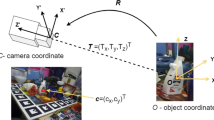Abstract
To address the issue of dynamic 3D circular features recognition in robot arm grasping, we propose a feature-based and incremental simultaneous points and circles structure from motion system. First, we represent the 3D target scene with sparse point cloud from multiple observations. The fundamental points construction pipeline combines the benefits of feature-based mapping and probabilistic depth estimation, which reduce the computational cost of generating practical 3D structures. Second, accurate 3D circles are extracted from the keyframes and are optimized in the backend. The circles construction pipeline attempts to find potential circles in the produced sparse point cloud and apply an adjusted level set method to do a novel 3D circle optimization process, which can work on keyframes smoothly. The integrated system is compared with other real-time construction systems and outperforms in industry scenes with more stable land-marks. Meanwhile the experimental results illustrate the ability of capturing circular features in target scenes.








Similar content being viewed by others
References
Miles WR (1931) Movement interpretations of the silhouette of a revolving fan. Am J Psychol 43(3):392–405
Mur-Artal R, Montiel JM, Tardós JD (2015) ORB-SLAM: a versatile and accurate monocular SLAM system. IEEE Trans Robot 31(5):1147–1163
Newcombe RA, Lovegrove SJ, Davison AJ (2011) DTAM: dense tracking and mapping in real-time. In: IEEE ICCV, pp 2320-2327
Forster C, Pizzoli M, Scaramuzza D (2014) SVO: fast semi-direct monocular visual odometry. In: IEEE ICRA, pp 15–22
Gibson JJ (1950) The perception of the visual world
Gomez-Ojeda R, Briales J, Gonzalez-Jimenez J (2016) PL-SVO: semi-direct monocular visual odometry by combining points and line segments. In: IEEE IROS, pp 4211–4216
Fu Z, Quo YY, Lin Z et al, (2017) FSVO: semi-direct monocular visual odometry using fixed maps. In: IEEE ICIP, pp 2553–2557
Nister D, Henrik S (2006) Scalable recognition with a vocabulary tree. IEEE CVPR 2:2161–2168
Tang J, Han X, Pan J, Jia K, Tong X (2019) A skeleton-bridged deep learning approach for generating meshes of complex topologies from single RGB images. In: CVPR, pp 4541–4550
Qin Z, Wang J, Lu Y (2019) Monogrnet: a geometric reasoning network for monocular 3d object localization. In: AAAI, pp 8851–8858
Wang J, Sun B, Lu Y (2019) MVPNet: multi-view point regression networks for 3D object reconstruction from a single image. In: AAAI, pp 8949–8956
Liu Y, Fan B, Xiang S, Pan C (2019) Relation-shape convolutional neural network for point cloud analysis. In: CVPR, pp 8895–8904
Natsume R, Saito S, Huang Z, Chen W, Ma C, Li H, Morishima S (2019) Siclope: silhouette-based clothed people. In: CVPR, pp 4480–4490
Stathopoulou EK, , Remondino F (2019) Semantic photogrammetry: boosting image-based 3D reconstruction with semantic labeling. In: International archives of the photogrammetry, remote sensing and spatial information sciences, vol 42, no 2
Ji SQ, Huang MB, Huang HP (2019) Robot intelligent grasp of unknown objects based on multi-sensor information. In: Sensors, vol 19, no 7, p 1595
Jabalameli A, Behal A (2019) From single 2D depth image to gripper 6D pose estimation: a fast and robust algorithm for grabbing objects in cluttered scenes. In: Robotics, vol 8, no 3, p 63
Mandikal P, KL N, Venkatesh Babu R (2018) 3D-PSRNet: part segmented 3D point cloud reconstruction from a single image. In: ECCV, p 0-0
Henderson P, Ferrari V (2019) Learning single-image 3D reconstruction by generative modelling of shape, pose and shading. arXiv:1901.06447
Kato H, Harada T (2019) Learning view priors for single-view 3d reconstruction. In: CVPR, pp 9778–9787
Rublee E (2011) ORB: an efficient alternative to SIFT or SURF. In: ICCV, vol 11, no 1, p 2
Locher A, Havlena M, Gool LV (2018) Progressive structure from motion. In: ECCV, pp 20–35
Pittaluga F, Koppal SJ, Kang SB, Sinha SN (2019) Revealing scenes by inverting structure from motion reconstructions. In: CVPR, pp 145–154
Lowe DG (2004) Distinctive image features from scale-invariant keypoints. ICCV 60(2):91–110
Pizzoli M, Forste C, Scaramuzza D (2014) REMODE: probabilistic, monocular dense reconstruction in real time. In: IEEE IROS, pp 2609–2616
Chen Z, Jen-Bin H (1999) A vision-based method for the circle pose determination with a direct geometric interpretation. In: IEEE transactions on robotics and automation, pp 1135–1140
Chan TF, Vese LA (2001) Active contours without edges. In: IEEE transactions on image processing, pp 266–277
Engel J, Koltun V, Cremers D (2017) Direct sparse odometry. IEEE Trans Pattern Anal Mach Intell 40(3):611–625
Engel J, Thomas S, Daniel C (2014) LSD-SLAM: large-scale direct monocular SLAM. In: European conference on computer vision, pp 834–849
Liu DC, Jorge N (1989) On the limited memory BFGS method for large scale optimization. In: Mathematical programming, pp 593–528
Sturm J, Burgard W, Cremers D (2012) Evaluating egomotion and structure-from-motion approaches using the TUM RGB-D benchmark. In: IEEE/RJS international conference on intelligent robot systems
Sturm J, Engelhard N, Endres F, Burgard W, Cremers D (2012) A benchmark for the evaluation of RGB-D SLAM systems. In : IEEE/RSJ international conference on intelligent robots and systems, pp 573–580
Rosten E, Porter R, Drummond T (2010) Faster and better: a machine learning approach to corner detection. IEEE Trans Pattern Anal Mach Intell 32(1):105–119
Jinyu L, Bangbang Y, Danpeng C, Nan W, Guofeng Z, Hujun B (2019) Survey and evaluation of monocular visual-inertial SLAM algorithms for augmented reality. Virtual Real Intell Hardw 1(4):386–410
Rodríguez-Jiménez S, Burrus N, Abderrahim M (2013) 3D object reconstruction with a single RGB-depth image. In: VISAP, pp 155–163
Van der Merwe M, Lu Q, Sundaralingam B, Matak M, Hermans T (2019) Learning continuous 3D reconstructions for geometrically aware grasping. arXiv:1910.00983
Author information
Authors and Affiliations
Corresponding author
Additional information
Publisher's Note
Springer Nature remains neutral with regard to jurisdictional claims in published maps and institutional affiliations.
Rights and permissions
About this article
Cite this article
Ni, T., Shi, Y., Sun, A. et al. Simultaneous identification of points and circles: structure from motion system in industry scenes. Pattern Anal Applic 24, 333–342 (2021). https://doi.org/10.1007/s10044-020-00889-2
Received:
Accepted:
Published:
Issue Date:
DOI: https://doi.org/10.1007/s10044-020-00889-2




